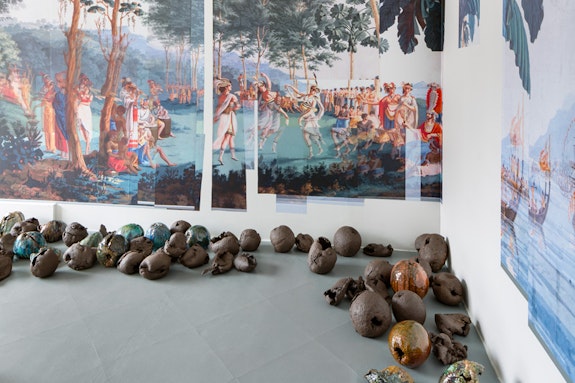ArtSeen
Rachelle Dang: Southern Oceans
On View
Motel GallerySeptember 15 – October 21, 2018
New York
A fragmented mural in which pale nymph-like figures gallivant under exotic-seeming trees; life-size copper shipping containers made to look oxidized by the elements; ceramic casts of breadfruit in various stages of ripeness and rot—these are the components of Southern Oceans (2018), a multifaceted and layered installation in Bedford Stuyvesant.
The work is by Rachelle Dang, a Brooklyn-based artist who was born in Hawaii and received her MFA from Hunter College last spring. Dang is in the throes of an obsession with the intersecting histories of botanical science, human conquest and colonization, and the Western gaze as it is transmuted into art.
Pause momentarily for a history lesson: It is 1805 in Revolutionary France. An artist named Jean-Gabriel Charvet is commissioned to design a wallpaper. For inspiration, Charvet goes off-shore, drawing on a combination of sketches made by Captain James Cook during his 18th century exploratory voyages to the South Pacific, and Charvet’s own travels to the Caribbean islands. The result is an over-200-square-foot panorama, a multi-hemisphere mashup of scientific observation and imagination known as Sauvages de la Mer Pacifique, or “Savages of the Pacific Ocean.” Hundreds of copies are sold. They’ll adorn the living room walls of the bourgeoisie. Around this time, Dang’s ancestors arrive in Hawaii from China to begin work on sugar plantations.
The nexus of these histories is the wellspring of Dang’s intellectual and aesthetic project. Southern Oceans is a conceptually rich work, which reminded me of other groundbreaking contemporary projects, like John Akomfrah’s Vertigo Sea (2015) and the arrival of palm trees at Storm King Art Center as part of Indicators, a visual colloquium on climate change.
A few years ago, Dang saw a surviving segment of Charvet’s wallpaper hanging at the Philadelphia Museum of Art. Fascinated by his depictions of distinct native communities and the relationship of those depictions to her own personal history, she took photographs with her iPhone. She then enlarged the images, creating a digital replica of the original piece, which was done with woodblock and paint. Dang has performed this reproduction several times, for several different installations, over the course of her career. Southern Oceans is the most disruptive; here she has superimposed images of non-adjacent sections to create less a reprint than a full-scale reimagining of Charvet’s conceit. Dang likes it this way. By digitally collaging her photographs, she has repurposed and re-appropriated what was always an appropriation and, in many ways, a misrepresentation.
“Hawaii and Tahiti are 2,600 miles apart,” Dang tells me. She is squatting next to her rendering of Charvet’s Tahitian dancers. “But on [Charvet’s] wallpaper they [appear] side-by-side. You’re talking thousands of miles apart, but they are like in a frieze or a diorama.”
The digital collage occupies most of the Motel’s three windowless walls. In the center of the gallery are two facsimiles of shipping containers that Dang made by spec, from the original blueprints. Hers are copper with a wind-and-sea-worn patina, and look like cages for animals or hutches for dinnerware. The originals had copper-plating that would have been tarnished by trans-oceanic trips on which they carried live plants, like breadfruit, which grow in the Caribbean today because they were brought from Tahiti as a subsistence crop for slaves of the British.
And here is where the breadfruit casts begin to factor into Dang’s tripartite installation. They loll around the floor like they have fallen from invisible trees. More disturbing, they are reminiscent of heads severed from necks. Some casts are more intact than others; some are glazed in energetic colors and some are dung-colored and dull. One group is fecund, taking on the color like a second skin, while the other, separated from its source—its native soil&mdash34; is wasting away. You can almost smell the decomposition.
The overall effect of Southern Oceans is of a physically large, immersive experience confined by Motel’s rather small space. Ideally, the installation would have multiple points of entry, or would be given more room for viewers to apprehend its many contours. Nonetheless, its three components—the wallpaper, the shipping containers, and the breadfruits—coalesce to form something like a body, a system that would not work were it not for all its pieces. Standing in the room, one feels as if one has arrived at the scape of Dang’s interior world.


